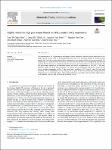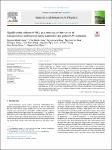Search
Author
- Nguyen, Manh Hung (1)
- Tran, Thi Ngoc Hoa (1)
Subject
- Gas sensors (1)
- H2S sensors (1)
- n-SnO2/n-WO3 heterojun... (1)
- Networked nanowires (1)
- next >
Search Results
The enhancement of the H2S gas-sensing performance of SnO2 nanowires is vital for practical application. In this study, H2S gas sensors based on WO3-coated SnO2 nanowires were fabricated through a two-step process, namely, the chemical vapor deposition of SnO2 nanowires and then coating with WO3 by sputtering method. The morphology and crystal structures of the SnO2 nanowires coated with WO3 were investigated by field-emission scanning electron microscopy, transmission electron microscopy, and energy-dispersive X-ray spectroscopy. The H2S gas-sensing properties of the fabricated sensors were tested at temperatures of 150–250 °C. The SnO2 nanowires coated with 5 nm WO3 showed the best response to low-concentration H2S gas (0.1–1 ppm). At the optimal working temperature of 200 °C, the... |
A unique combination of high response and fast response-recovery is still a challenge in the development of room-temperature gas sensors. Herein, we demonstrated the on-chip growth of nanojunction-networked SnO2 NW sensors to work under UV-radiation at room temperature. The morphological, compositional, and structural properties of synthesized SnO2 nanowires were examined using field emission electron microscopy, energy dispersive spectroscopy, X-ray diffraction, and high-resolution transmission electron microscopy, respectively. The results presented the SnO2 NWs with smooth surfaces were entangled between the Pt electrode. Besides, the internal properties showed the SnO2 NWs were crystallized as the tetragonal rutile structure of SnO2. The use of UV-radiation with the optimum inte... |


